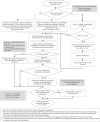First Iranian guidelines for the diagnosis, management, and treatment of hyperlipidemia in adults
- PMID: 38808220
- PMCID: PMC11132424
- DOI: 10.4103/jrms.jrms_318_23
First Iranian guidelines for the diagnosis, management, and treatment of hyperlipidemia in adults
Abstract
This guideline is the first Iranian guideline developed for the diagnosis, management, and treatment of hyperlipidemia in adults. The members of the guideline developing group (GDG) selected 9 relevant clinical questions and provided recommendations or suggestions to answer them based on the latest scientific evidence. Recommendations include the low-density lipoprotein cholesterol (LDL-C) threshold for starting drug treatment in adults lacking comorbidities was determined to be over 190 mg/dL and the triglyceride (TG) threshold had to be >500 mg/dl. In addition to perform fasting lipid profile tests at the beginning and continuation of treatment, while it was suggested to perform cardiovascular diseases (CVDs) risk assessment using valid Iranian models. Some recommendations were also provided on lifestyle modification as the first therapeutic intervention. Statins were recommended as the first line of drug treatment to reduce LDL-C, and if its level was high despite the maximum allowed or maximum tolerated drug treatment, combined treatment with ezetimibe, proprotein convertase subtilisin/kexin type 9 inhibitors, or bile acid sequestrants was suggested. In adults with hypertriglyceridemia, pharmacotherapy with statin or fibrate was recommended. The target of drug therapy in adults with increased LDL-C without comorbidities and risk factors was considered an LDL-C level of <130 mg/dl, and in adults with increased TG without comorbidities and risk factors, TG levels of <200 mg/dl. In this guideline, specific recommendations and suggestions were provided for the subgroups of the general population, such as those with CVD, stroke, diabetes, chronic kidney disease, elderly, and women.
Keywords: Adult; Iran; clinical practice guideline; hyperlipidemia.
Copyright: © 2024 Journal of Research in Medical Sciences.
Conflict of interest statement
There are no conflicts of interest.
Figures



Similar articles
-
2017 Taiwan lipid guidelines for high risk patients.J Formos Med Assoc. 2017 Apr;116(4):217-248. doi: 10.1016/j.jfma.2016.11.013. Epub 2017 Feb 24. J Formos Med Assoc. 2017. PMID: 28242176 Review.
-
[ECS guidelines 2016 - dyslipidaemias].Herz. 2016 Dec;41(8):671-676. doi: 10.1007/s00059-016-4505-6. Herz. 2016. PMID: 27844136 Review. German.
-
Update of the clinical guideline for hypertension diagnosis and treatment in Iran.Clin Hypertens. 2024 Jun 1;30(1):13. doi: 10.1186/s40885-024-00269-6. Clin Hypertens. 2024. PMID: 38822442 Free PMC article.
-
2017 Focused Update of the 2016 ACC Expert Consensus Decision Pathway on the Role of Non-Statin Therapies for LDL-Cholesterol Lowering in the Management of Atherosclerotic Cardiovascular Disease Risk: A Report of the American College of Cardiology Task Force on Expert Consensus Decision Pathways.J Am Coll Cardiol. 2017 Oct 3;70(14):1785-1822. doi: 10.1016/j.jacc.2017.07.745. Epub 2017 Sep 5. J Am Coll Cardiol. 2017. PMID: 28886926
-
AMERICAN ASSOCIATION OF CLINICAL ENDOCRINOLOGISTS AND AMERICAN COLLEGE OF ENDOCRINOLOGY GUIDELINES FOR MANAGEMENT OF DYSLIPIDEMIA AND PREVENTION OF CARDIOVASCULAR DISEASE.Endocr Pract. 2017 Apr;23(Suppl 2):1-87. doi: 10.4158/EP171764.APPGL. Endocr Pract. 2017. PMID: 28437620
Cited by
-
Development of Iranian clinical practice guidelines: An experience in cardiovascular diseases-A policy brief.J Res Med Sci. 2025 Mar 29;30:16. doi: 10.4103/jrms.jrms_617_24. eCollection 2025. J Res Med Sci. 2025. PMID: 40302999 Free PMC article.
References
-
- Hill MF, Bordoni B. StatPearls [Internet] Treasure Island (FL): StatPearls Publishing; 2023. Hyperlipidemia.
-
- Grundy SM, Arai H, Barter P, Bersot TP, Betteridge DJ, Carmena R, et al. An international atherosclerosis society position paper: Global recommendations for the management of dyslipidemia: Executive summary. Atherosclerosis. 2014;232:410–3. - PubMed
LinkOut - more resources
Full Text Sources
Miscellaneous
